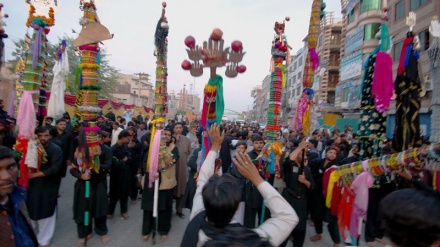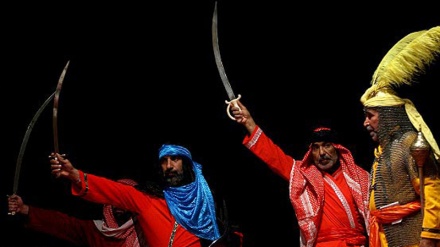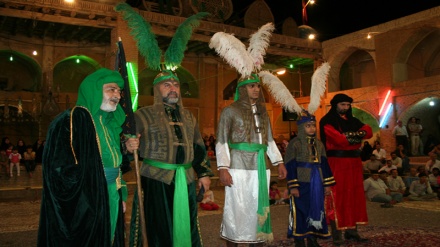Muharram mourning traditions in different lands - 17
Welcome to the 17th part of the 40-plus episodes of a new and interesting series titled “Muharram Mourning Traditions in Different Lands” that we started broadcasting as of October 15 on a daily basis, to commemorate the heartrending tragedy of Karbala, and the martyrdom of Imam Husain (AS), the grandson of Prophet Mohammad (SAWA).
In this series, which delves into the various mourning traditions associated with the Immortal Epic of Ashura in various lands, we look at the history of mourning for Imam Husain (AS). In this episode, we discuss further development of the Muharram mourning ceremonies in Iran during the Zand and Qajarid periods.
During the Afshar and Zandiyeh period, many forms of mourning for Muharram and Ashura were further developed in Iran. For example, Ta’ziya, which is a form of religious drama recounting the tragic events of Ashura, is an art form which was further developed in the Zand period, during the reign of Karim Khan Zand. According to historians, Karim Khan ordered a special form of drama, known as Ta’ziya, from the Arabic word Aza, which means mourning or grief and which depict the events which led to the Martyrdom of Imam Husain (AS) and his kin and loyal companions, to be performed in public as a tribute to the Martyrs of Karbala. Some scholar believe the Ta’zia was born in the end of the 17th century; when the costumed marchers of the dasta began to recite the stories of the Rowza-Khwani. The story lines of the Rowza-Khwani were converted into the dramatic texts of the Ta’zia.
The movement of the parade was changed into the motions of the actors; the parade costumes became stage costumes. In the beginning, it was a short playlet integrated into the procession and performed at street corners. Soon, however, Ta’zia was separated from the parade and became an independent event performed in the open—in courtyards, private houses, and special buildings called Takiyeh. In the second half of the 19th century, these buildings were major features in Iranian towns. These were mainly built by the well-to-do as a pious act and a public service. Some edifices could seat thousands of spectators, but most accommodated only a few hundreds. Many were temporary structures built especially for the Muharram observances
This practice continued in the Qajarid period, and in fact, it was the Message of the Martyr of Karbala that inspired Iranians to resist against both domestic oppression and foreign hegemony. This is evident in the movement against the consumption of Tobacco in the late 19th century when Nasser od-Din Shah was forced to cancel the monopoly he had given to a British company. The Constitutional Movement that followed was also a manifestation of the devotion of the Iranian people to Imam Husain (AS). The most famous Takiyeh theater was the Takiyeh Dowlat or the Royal Theater in Tehran, built in the 1870s by Nasser od-Din Shah.
According to many European visitors, its dazzling splendor and intensity of dramatic action overshadowed even the opera houses in Western capitals. The first American envoy to Persia, Samuel Benjamin, who stayed in Iran Persia in 1883-85, was invited by the royal court to attend the Muharram celebrations at the Takiyeh Dowlat and recorded his impressions: “On looking over the vast arena a sight met my gaze which was indeed extraordinary. The interior of the building is nearly two hundred feet in diameter and some eighty feet high. A domed frame of timbers, firmly spliced and braced with iron, springs form the walls, giving support to the awning that protects the interior from the sunlight and rain. ... A more oriental form of illuminating the building was seen in the prodigious number of lustres and candlesticks, all of glass and protected from the air by glass shades open on the top and variously colored; they were concentrated against the wall in immense glittering clusters. Estimating from those attached on one box, I judged that there were upwards of five thousand candles in these lustres. ... In the center of the arena was a circular stage of masonry, raised three feet and approached by two stairways. On one side of the building a pulpit of white marble was attached to the wall. The entire arena with the exception of a narrow passage around the stage was absolutely packed with women, thousands on thousands. At a rough estimate it seemed to me that quite four thousand women were seated there cross-legged on the earthen floor, which was made slightly sloping in order to enable those in the rear to see over the heads of those before them”
Women in particular have been attached to Ta’zia, not only out of devotion, but also due to a natural empathy with the women at Karbala which causes their own sufferings to pale in comparison. Women in Iranian Ta’zia appear in two entirely contrasted countenances: in the good countenance of the protagonist and in the evil demeanor of the antagonists. In the first category, woman is good, chaste, pure, innocent, and gentle. She is compassionate and acquainted with pain and suffering. A self-sacrificing devotee, who is ready to endure great hardship for the sake of relatives, friends, and companions, she has no fear of bloody and painful events or the perilous surroundings in which she finds herself. She faces bravely the tempest of calamity and affliction. Her kindness places her at the apex of manifested glory. And her generosity is exemplary. The relationships between men and women at Karbala are delineated only by expressions of respect and admiration.
Ta’zia was no longer restricted to the first ten days of Muharram. It is now performed throughout the months of Muharram and Safar. In Ta’zia, the battle is divided into many different episodes performed on separate days. The only fixed day and play in the Muharram repertory is the martyrdom of Imam Ḥusain (AS) on the tenth day or Ashura, while other episodes can be performed in varying sequence. Usually, the cycle begins on the first day of Muharram with a play commemorating the martyrdom of the Imam’s emissary to Kufa, Muslim bin Aqeel. This is followed by a daily progression of plays, each devoted to the martyrdom of various members of the Imam’s family or his companions. These performances move the audience to tears accompanied at times by loud wails and lamentations, as part of tribute to the Martyrs of Karbala.
AS/MG


